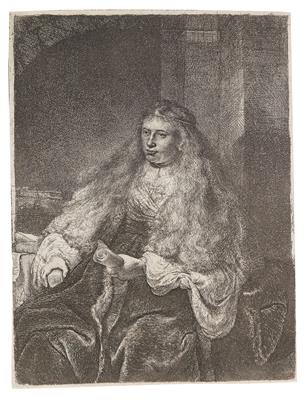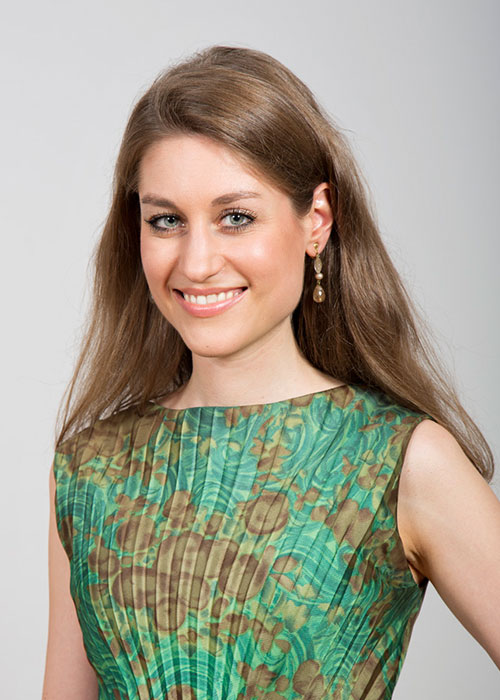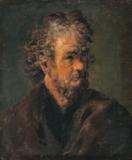Rembrandt Harmensz van Rijn

(Leiden 1606-1669 Amsterdam)
The Great Jewish Bride, 1635, etching, engraving and drypoint, signed and dated R 1635 in the plate, on laid paper, with watermark "Straßburg Lily in a crowned escutcheon" (Ash-Fletcher 36), 21,9 x 16,8 cm, with tiny margins along platemarks, Bartsch 340, White-Boon 340 III (of IV), New Hollstein 154 III (of V), mounted, unframed, (Sch)
Provenance:
Collection Eduard Friedrich Weber (1830–1907), Hamburg;
Collection Paul Davidsohn (1839–1931), Berlin, (see inscription);
Their auction C. G. Boerner, Leipzig, 26. April 1921, lot 256;
unknown stamp „Doppeladler im Kreis“ (?);
European private collection
Very excellent, vigorous impression with rich contrasts of the rare IIIrd state (of IV), before the shading of the hands and the finishing retouches in the background. With the watermark mentioned by New Hollstein for this state "Straßburg Lily in a crowned escutcheon " (Ash-Fletcher 36), dated c. 1635. In an excellent condition. Very rare.
The title of the present etching dated 1635, „The Great Jewish Bride“ goes back to a tradition in the 18th century according to which a bride approaches her husband with open hair and the Ketubah, a prenuptial agreement document where the groom’s rights and responsibilities are explained. Rembrandt lived in the Jewish quarter of Amsterdam and was therefore well informed about the customs and traditions of his Jewish neighbourhood. The woman depicted was Rembrandt’s first wife, Saskia Uylenburgh, who he had married one year before the execution of the etching. She was Rembrandt’s model for several of his compositions. Saskia with open hair reappears in an etching „The Small Jewish Bride“ dated 1638. This etching is considered a study for Saint Catherine, because the figure is depicted with a wheel. It is not known who Saskia may represent in the present etching; it is assumed that she may be the biblical figure of Esther, by means of the paper scroll, which the woman is holding in her hand in the third and present state and in the later ones. The paper scroll may point to the written order of Esther, according to which all jews living in Persia should be murdered. Esther approached her husband King Ahasverus majestically with the document in order to prevent her people from being murdered.
The present etching which doubtlessly counts to the most significant and most popular subjects in Rembrandt‘s oeuvre is the third of five plate states. The first two states only show the face and the shoulders of the model. The present etching is the extremely magnificent, early and very rare impression with the characteristic watermark „Straßburger lily in a crowned escutcheon“ mentioned for this state by New Holstein 154 (Ash-Fletcher 36) and which is dated 1635. Impressions of the third state of the present quality are very rare to find on the art market. Comparable impressions are preserved in the Graphic Collection of the Albertina in Vienna (Inv. DG1926/524), in the Kupferstichkabinett in Berlin (Inv. 81-1877), in the Fitzwilliam Museum in Cambridge (Inv. AD.12.39177) and in the British Museum in London (Inv. F,6.1110).
Specialist: Mag. Astrid-Christina Schierz
 Mag. Astrid-Christina Schierz
Mag. Astrid-Christina Schierz
+43-1-515 60-546
astrid.schierz@dorotheum.at
02.10.2018 - 15:00
- Realized price: **
-
EUR 50,000.-
- Estimate:
-
EUR 40,000.- to EUR 60,000.-
Rembrandt Harmensz van Rijn
(Leiden 1606-1669 Amsterdam)
The Great Jewish Bride, 1635, etching, engraving and drypoint, signed and dated R 1635 in the plate, on laid paper, with watermark "Straßburg Lily in a crowned escutcheon" (Ash-Fletcher 36), 21,9 x 16,8 cm, with tiny margins along platemarks, Bartsch 340, White-Boon 340 III (of IV), New Hollstein 154 III (of V), mounted, unframed, (Sch)
Provenance:
Collection Eduard Friedrich Weber (1830–1907), Hamburg;
Collection Paul Davidsohn (1839–1931), Berlin, (see inscription);
Their auction C. G. Boerner, Leipzig, 26. April 1921, lot 256;
unknown stamp „Doppeladler im Kreis“ (?);
European private collection
Very excellent, vigorous impression with rich contrasts of the rare IIIrd state (of IV), before the shading of the hands and the finishing retouches in the background. With the watermark mentioned by New Hollstein for this state "Straßburg Lily in a crowned escutcheon " (Ash-Fletcher 36), dated c. 1635. In an excellent condition. Very rare.
The title of the present etching dated 1635, „The Great Jewish Bride“ goes back to a tradition in the 18th century according to which a bride approaches her husband with open hair and the Ketubah, a prenuptial agreement document where the groom’s rights and responsibilities are explained. Rembrandt lived in the Jewish quarter of Amsterdam and was therefore well informed about the customs and traditions of his Jewish neighbourhood. The woman depicted was Rembrandt’s first wife, Saskia Uylenburgh, who he had married one year before the execution of the etching. She was Rembrandt’s model for several of his compositions. Saskia with open hair reappears in an etching „The Small Jewish Bride“ dated 1638. This etching is considered a study for Saint Catherine, because the figure is depicted with a wheel. It is not known who Saskia may represent in the present etching; it is assumed that she may be the biblical figure of Esther, by means of the paper scroll, which the woman is holding in her hand in the third and present state and in the later ones. The paper scroll may point to the written order of Esther, according to which all jews living in Persia should be murdered. Esther approached her husband King Ahasverus majestically with the document in order to prevent her people from being murdered.
The present etching which doubtlessly counts to the most significant and most popular subjects in Rembrandt‘s oeuvre is the third of five plate states. The first two states only show the face and the shoulders of the model. The present etching is the extremely magnificent, early and very rare impression with the characteristic watermark „Straßburger lily in a crowned escutcheon“ mentioned for this state by New Holstein 154 (Ash-Fletcher 36) and which is dated 1635. Impressions of the third state of the present quality are very rare to find on the art market. Comparable impressions are preserved in the Graphic Collection of the Albertina in Vienna (Inv. DG1926/524), in the Kupferstichkabinett in Berlin (Inv. 81-1877), in the Fitzwilliam Museum in Cambridge (Inv. AD.12.39177) and in the British Museum in London (Inv. F,6.1110).
Specialist: Mag. Astrid-Christina Schierz
 Mag. Astrid-Christina Schierz
Mag. Astrid-Christina Schierz
+43-1-515 60-546
astrid.schierz@dorotheum.at
|
Buyers hotline
Mon.-Fri.: 10.00am - 5.00pm
kundendienst@dorotheum.at +43 1 515 60 200 |
| Auction: | Master Drawings, Prints before 1900, Watercolours, Miniatures |
| Auction type: | Saleroom auction |
| Date: | 02.10.2018 - 15:00 |
| Location: | Vienna | Palais Dorotheum |
| Exhibition: | 22.09. - 02.10.2018 |
** Purchase price incl. charges and taxes
It is not possible to turn in online buying orders anymore. The auction is in preparation or has been executed already.
More objects by this artist
-

Workshop of Rembrandt van Rijn
Estimate:
EUR 20,000.- to EUR 30,000.- -

Estimate:
EUR 3,000.- to EUR 5,000.-
